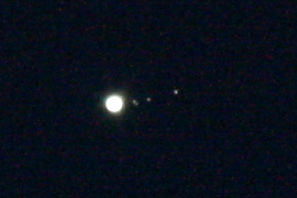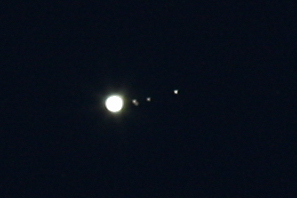Another problem is in the camera's sensor itself. Many sky objects are dim, so it is necessary to increase the ISO setting -- analogous to the old "film speed." Higher light sensitivity allows dimmer objects to be imaged. Except for the pesky noise. Higher ISO values result in random image artifacts -- visual "noise" that detracts from the image.
Mike to the rescue! He found a freeware software tool that significantly helps with both of these problems: RegiStax, which implements a concept called image stacking. The idea is simple: take many pictures of the same object. Details that are smudged by air movement in one frame will likely be sharper in another frame. Also, random image noise can be subtracted because the "real" image is not random.
As a test, I cranked up my camera's ISO to 1,600 -- a level that is guaranteed to cause significant image noise. Then, I shot 23 pictures of Jupiter through an almost-dark dusky sky. The result was about what I expected: grainy photos of an inconsistent image of Jupiter and its moons. Here is the best of the 23:

After running the 23 shots through RegiStax, the image had a stunning improvement of clarity and quality:

Another tool in the arsenal for this casual astrophotographer! (Thanks, Mike!)

1 comment:
I think that the exposure variance problem calls for HDR techniques, either manual (as in "Bashful Moon") or automatic (as in "Bashful Moon Meets Mr. HDR).
Maybe I'll give it a try with the original images from "Jupiter and His Minions."
Post a Comment